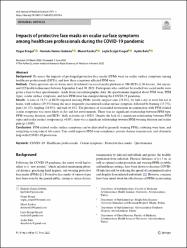| dc.contributor.author | Eroğul, Özgür | |
| dc.contributor.author | Gobeka, Hamidu Hamisi | |
| dc.contributor.author | Kaşıkçı, Murat | |
| dc.contributor.author | Eryiğit Eroğul, Leyla | |
| dc.contributor.author | Balcı, Aydın | |
| dc.date.accessioned | 2022-06-16T07:12:37Z | |
| dc.date.available | 2022-06-16T07:12:37Z | |
| dc.date.issued | 13.06.2022 | en_US |
| dc.identifier.issn | 1863-4362 | |
| dc.identifier.uri | https://doi.org/10.1007/s11845-022-03059-x | |
| dc.identifier.uri | https://hdl.handle.net/20.500.12933/1179 | |
| dc.description.abstract | Background
To assess the impacts of prolonged protective face masks (PFM) wear on ocular surface symptoms among healthcare professionals (HCPs), and how these symptoms affected PFM wear.
Methods
Thirty-question survey forms were distributed via social media platform to 396 HCPs (110 doctors, 164 nurses, and 122 health technicians) between September 8 and 30, 2021. Participants who could not be reached via social media were given a face-to-face questionnaire. Aside from sociodemographic data, the questionnaire inquired about PFM wear, PFM types, ocular surface symptoms, and how PFM wear has changed during the COVID-19 pandemic.
Results
A total of 74.5% of HCPs reported wearing PFMs, mostly surgical ones (76.8%), for half a day at work but not at home, with redness (29.3%) being the most frequently encountered ocular surface symptom, followed by burning (15.7%), pain (14.1%), tingling (10.9%), and rash (6.6%). The presence of associated restrictions in conjunction with PFM-related ocular symptoms was more likely in dry and hot environments. There was no significant relationship between PFM type, PFM-wearing duration, and HCPs’ daily activities (p > 0.05). Despite the lack of a significant relationship between PFM types and ocular surface symptoms (p > 0.05), there was a significant relationship between PFM-wearing duration and ocular pain (p < 0.05).
Conclusions
PFM-related ocular surface symptoms can be alleviated by properly wearing PFMs, reducing wear time, and using long-acting topical lubricants. This could improve PFM wear compliance, prevent disease transmission, and ultimately help with COVID-19 protection. | en_US |
| dc.language.iso | eng | en_US |
| dc.publisher | Springer | en_US |
| dc.relation.isversionof | 10.1007/s11845-022-03059-x | en_US |
| dc.rights | info:eu-repo/semantics/embargoedAccess | en_US |
| dc.subject | COVID -19 | en_US |
| dc.subject | Healthcare professionals | en_US |
| dc.subject | Ocular symptoms | en_US |
| dc.subject | Protective face masks | en_US |
| dc.subject | Questionnaire | en_US |
| dc.title | Impacts of protective face masks on ocular surface symptoms among healthcare professionals during the COVID-19 pandemic | en_US |
| dc.type | article | en_US |
| dc.authorid | 0000-0002-0875-1517 | en_US |
| dc.authorid | 0000-0002-6723-2418 | en_US |
| dc.department | AFSÜ, Tıp Fakültesi, Cerrahi Tıp Bilimleri Bölümü, Göz Hastalıkları Ana Bilim Dalı | en_US |
| dc.contributor.institutionauthor | Eroğul, Özgür | |
| dc.contributor.institutionauthor | Balcı, Aydın | |
| dc.identifier.startpage | 1 | en_US |
| dc.identifier.endpage | 6 | en_US |
| dc.relation.journal | Irish Journal of Medical Science | en_US |
| dc.relation.publicationcategory | Makale - Ulusal Hakemli Dergi - Kurum Öğretim Elemanı | en_US |
















